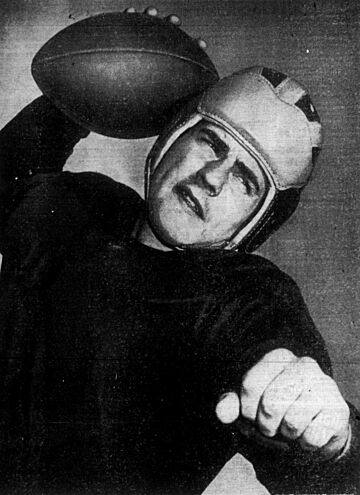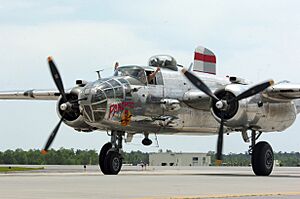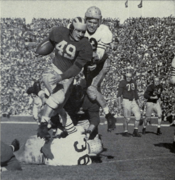Bob Chappuis facts for kids
| No. 49 | |

Chappuis in 1947
|
|
| Born: | February 24, 1923 Toledo, Ohio, U.S. |
|---|---|
| Died: | June 14, 2012 (aged 89) Ann Arbor, Michigan, U.S. |
| Career information | |
| Position(s) | HB/QB |
| College | University of Michigan |
| NFL draft | 1947 / Round: 5 / Pick: 26 |
| Drafted by | Detroit Lions |
| Career history | |
| As player | |
| 1948 | Brooklyn Dodgers |
| 1949 | Chicago Hornets |
| Career highlights and awards | |
| Records | Big Ten Conference Records Single-season passer rating (1947–) Michigan Records |
|
|
| Military career | |
| Allegiance | United States of America |
| Service/ |
U.S. Army Air Forces |
| Years of service | 1943–1945 |
| Rank | Lieutenant |
| Battles/wars | World War II European Theater of Operations |
Robert "Bob" Richard Chappuis (born February 24, 1923 – died June 14, 2012) was a famous American football player. He played as a halfback and quarterback for the University of Michigan Wolverines. His college career was paused when he served in the U.S. Army Air Forces during World War II.
Chappuis flew 21 missions as a radio operator and aerial gunner on B-25 bombers. His plane was shot down in Italy in 1945. He parachuted to safety and was rescued by Italian resistance fighters. They hid him for three months until the war ended.
After the war, Chappuis returned to Michigan. He broke the Big Nine Conference record for total offense in both 1946 and 1947. He led the 1947 Michigan team, nicknamed the "Mad Magicians," to a perfect season. They won the 1948 Rose Bowl game 49–0 against the USC Trojans.
Chappuis was chosen as an All-American in 1947. He was also named the Most Valuable Player of the 1948 Rose Bowl. His picture even appeared on the cover of Time magazine in 1947. He finished second in the voting for the 1947 Heisman Trophy, a top award for college football players.
Contents
Early Life and College Start
Bob Chappuis was born and grew up in Toledo, Ohio. His father had played quarterback in college. When it was time for Bob to choose a college, his dad only asked that he not go to Ohio State. Bob wasn't sure why, but his dad "just didn't like Ohio State."
Chappuis went to DeVilbiss High School where he was a football star. He started playing for Michigan as a sophomore in 1942. In his very first college game, he completed seven passes and ran for 49 yards. This was a great start to his college career.
Serving in World War II
Bob Chappuis' college football career was put on hold for three years. He served in the military from 1943 to 1945 during World War II. He became a Lieutenant in the U.S. Army Air Forces.
He flew 21 missions as a radio operator and aerial gunner. His crew once sank a warship in an Italian harbor. This earned them a special award in September 1944.
On February 13, 1945, Chappuis was on his 21st mission. His B-25 bomber was hit by enemy fire. Both engines stopped working. When the order came to bail out, he helped a fellow crew member who was stuck. Then, he jumped from the plane.
An Italian partisan named Aldo Comucci rescued Chappuis. Comucci and his group of fighters found Chappuis before the Germans did. They hid Bob and two other American flyers from his plane. They kept them safe for almost three months until the war ended. The partisans moved the Americans from house to house, trying to get them to the Swiss border.
Chappuis and his crewmates finally reached a home in a small Italian town called Asola. The German headquarters was very close by. The Americans had to be very careful not to be seen or heard. They spent their time playing cards and reading.
When the war ended in May 1945, Chappuis and his friends celebrated with the people of Asola. They had a big party and danced. After returning to the United States, Chappuis stayed in touch with the families who helped him. He also kept in contact with Aldo Comucci, the resistance leader. In 1974, Chappuis went back to Italy to meet Comucci. A year later, Comucci and his wife visited Chappuis in Michigan.
Becoming an All-American at Michigan
1946 Football Season
After the war, Chappuis returned to Michigan in the spring of 1946. He even played for the Michigan baseball team. He was the best hitter on the team and helped them win a championship.
When football season started, many veterans like Chappuis returned to play. Coach Fritz Crisler thought it might take time for them to get back into shape. Chappuis was 23 years old when he came back to school. He later said Coach Crisler "really whipped us into shape."
Despite any challenges, Chappuis broke a major record in 1946. He broke the Big Nine Conference record for total offensive yards. He gained 1,284 yards that season. What's even more amazing is that he played the entire season with a fractured bone in his wrist! He didn't tell anyone until after the season. He knew if he reported it, he would be benched.
1947 Football Season
Even after wrist surgery, Chappuis had an incredible 1947 season. He broke his own Big Nine total offense record. He gained 1,405 yards this time. He completed 48 out of 84 passes for 976 yards, including 11 touchdown passes. He also ran for 544 yards and scored 5 touchdowns.
In the first game, Michigan won 55–0 against Michigan State. Chappuis scored three touchdowns. Michigan finished the season with a 21–0 win over Ohio State. In his last game at Michigan Stadium, Chappuis set a school record for total offense that lasted for 20 years.
At the end of the 1947 season, Chappuis was named a unanimous first-team All-American. He also came in second place for the 1947 Heisman Trophy. Despite all the praise, Chappuis remained humble. He gave credit to his teammates. He said, "Anyone passing behind the protection that line gave me could have done as well."
Chappuis was also a leader on campus. He was elected president of his fraternity. He appeared on the cover of Look magazine in October 1947. The magazine featured pictures of him playing football and around campus.
A Passing "Specialist"
Chappuis became famous for his passing skills. He was one of the first "specialists" in football. In 1947, Time magazine featured him on its cover. The article called him "The Specialist." It talked about how Coach Fritz Crisler used separate offensive and defensive teams. Chappuis was Michigan's "prize specialist."
His main job was to throw forward passes. Time magazine said no one in college football did it better in 1947. Coach Crisler called Chappuis "the finest passer I have ever handled." He said Chappuis played "as though he had ice water in his veins." Crisler believed great passers are born with special vision. Chappuis had amazing vision for finding his receivers.
When Chappuis graduated, he held many school records. He had the most career touchdown passes with 23. This record lasted for 30 years! He also held the record for most touchdown passes in a season with 13.
1948 Rose Bowl Game
Chappuis played his final game for Michigan in the 1948 Rose Bowl. Michigan won 49–0 against the USC Trojans. Chappuis ran for 91 yards and completed 14 passes for 188 yards. He was named the Most Valuable Player of the game. He also set new Rose Bowl records for total offense and pass completions.

Chappuis was also chosen to play in the College All-Star game. He played against the Chicago Cardinals, who were the NFL champions.
A College Celebrity
Bob Chappuis became a celebrity at Michigan. He was mentioned in Time magazine several times. His wedding was even announced in the magazine. His time at Michigan was so memorable that people would refer to it as "the Chappuis years." In 1988, he was honored by being elected into the College Football Hall of Fame.
Professional Football Career
After college, Chappuis was drafted by the Pittsburgh Steelers. However, he chose to play for the new All-America Football Conference (AAFC). In 1948, he signed with the Brooklyn Dodgers. The Dodgers wanted him because they believed in having a strong passing quarterback.
Chappuis played in 13 games for the Dodgers in 1948. He led the team in total offense. He completed 100 passes for 1,402 yards and 8 touchdowns. He also ran for 310 yards. The Dodgers team struggled and closed down after the 1948 season.
In 1949, Chappuis played for the Chicago Hornets, also in the AAFC. He had limited playing time that year. When the AAFC league ended after the 1949 season, Chappuis decided to retire from football. He announced his retirement in June 1950. He said he wanted to enjoy a more relaxed life. He also wanted to be able to visit Ann Arbor for college football games.
Life After Football
After retiring from football, Bob Chappuis worked in different businesses. In the 1950s, he worked in the electrical appliance business. He then spent 13 years with Central Soya Co. in Fort Wayne, Indiana. He retired in 1983 as a Vice President. Later, he started his own business.
Chappuis and his wife, Ann, had four children. Bob Chappuis passed away on June 14, 2012, at the age of 89. In 2012, he was inducted into the Michigan Sports Hall of Fame.
Honors and Awards
Bob Chappuis received many honors for his amazing football career:
- Named Most Valuable Player for the 1946 Michigan Wolverines football team.
- Chosen for the All-Big Nine Conference team in 1946 and 1947.
- Unanimous All-American in 1947.
- Finished second in the Heisman Trophy voting in 1947.
- Named Most Valuable Player of the 1948 Rose Bowl game.
- Inducted into the University of Michigan Hall of Honor in 1984.
- Inducted into the College Football Hall of Fame in 1988.
- Inducted into the Rose Bowl Hall of Fame in 1992.
- In 2005, he was selected as one of the 100 greatest Michigan football players of all time.
See also
- List of Michigan Wolverines football All-Americans
- University of Michigan Athletic Hall of Honor



